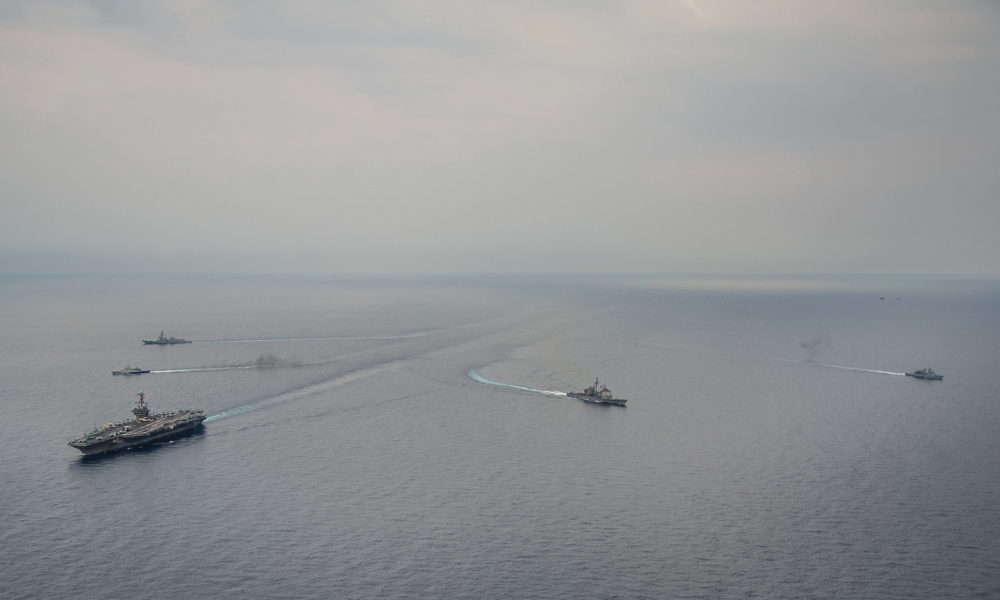Geography Is a Dealbreaker for Coalition Building in Asia

Published by The Lawfare Institute
in Cooperation With

Editor’s Note: The Biden administration has launched an ambitious effort to work with allies and partners in Asia to counter China. My Georgetown University colleagues Kelly Grieco and Jennifer Kavanagh, who are also senior fellows at the Stimson Center and Defense Priorities, respectively, argue that the United States is trying to do too much and that it will fail as a result. They point to numerous limits and highlight in particular the role of geography in shaping the responses of states in Asia.
Daniel Byman
***
At the 2024 Shangri-La Dialogue in Singapore, Secretary of Defense Lloyd Austin touted a “new convergence” between the United States and its Indo-Pacific allies and partners that is “defining a new era of security in the Indo-Pacific.” Austin came with a list of accomplishments to back it up, hailing expanded U.S. military access to bases in Australia and the Philippines, a “new era” in U.S.-Japan-South Korea trilateral cooperation, and co-production deals with India.
But this “new convergence” is more of an illusion than reality. As we argued in a longer piece in the Washington Quarterly, the United States still lacks military access to critical parts of Asia, a robust regional security network, and well-armed allies and partners capable of self-defense. Worse, trying harder will not solve these myriad problems because the region’s geography—its vast distances and maritime environment—works against coalition-building. Instead of trying to outmatch or outcompete China, Washington should acknowledge the geographic reality and build a more narrow but sustainable coalition to balance Chinese power and prevent Beijing’s regional hegemony.
The Indo-Pacific Mirage
Despite its boasting, the Biden administration has made only limited progress toward any “convergence” in Asia. First, the United States still lacks the military access it needs to establish a more distributed and survivable force posture against China’s missile threats. New access permissions have done little to remedy this situation, as both the Philippines and Papua New Guinea have said the United States cannot conduct strike operations from their soil in a Taiwan contingency.
Second, most allies and partners—including Taiwan—continue to underinvest in their own defense and spend far too much on big-ticket items like fighter jets and warships, rather than on the anti-ship and anti-air missiles, drones, and sea mines they need to turn themselves into hard-to-conquer porcupines.
Finally, even the administration’s signature project—building a “latticework” of overlapping security partnerships in the region—has met with limited success. Few countries are willing to fully commit to U.S. security networks that they perceive—rightly or wrongly—as requiring them to choose between the United States and China. In December 2023, for example, a few months after entering a Comprehensive Strategic Partnership with the United States—and raising expectations for closer alignment between Hanoi and Washington on security issues—Vietnam also elevated its relationship with Beijing as part of a carefully balanced refusal to take sides.
Though the administration has acknowledged some remaining gaps, officials continue to express confidence that as China’s military assertiveness in the region grows, the U.S.-led coalition will become stronger—with more and better armed members and wider access permissions. But this expectation discounts the geographic reality of the Indo-Pacific.
The Problem of Geography
The region’s sheer size, its expansive oceans and seas, and the unique maritime characteristics of Indo-Pacific states themselves pose intractable barriers to building the region-wide coalition in Asia that Washington expects.
First, the region’s vast distances dampen many regional states’ threat perceptions of China. Many U.S. partners consider hot spots like the Taiwan Strait and the Second Thomas Shoal to be distant concerns. The size of the Indo-Pacific theater—covering 50 percent of Earth’s surface—prevents the emergence of the shared security interests that might serve as the foundation of a regional coalition. Countries like Malaysia and Indonesia have little direct concern about the fate of Taiwan, which is some 1,800 miles away and peripheral to their own security. At the same time, by challenging the U.S. ability to project combat power, the region’s size erodes the perceived benefits of joining U.S-led. coalitions.
Second, the region’s maritime geography offers a powerful defensive barrier—what the political scientist John Mearsheimer terms “the stopping power of water.” This defensive advantage discourages states from making large investments in defense or turning to a balancing coalition for protection. China’s neighbors are wary of its growing power, but few see it as posing an existential threat to their survival. The maritime environment also gives them reason to question the credibility of U.S. commitments, as the air and naval assets that the United States relies on in the region are highly mobile—easy to deploy and easy to withdraw—and raise the perceived risks of lining up behind the United States.
Finally, the unique geographies of Asia’s maritime states tend to focus attention inward and on local security issues and away from more distant regional security threats. Archipelagic states like Japan, the Philippines, and Indonesia, for example, prioritize protecting their dispersed sovereignty—specifically the internal waters that lie between their many islands. These internal concerns may sometimes overlap with U.S. priorities—as is the case with Japan, as its archipelago extends toward Taiwan—but mostly they reduce regional demand for balancing coalitions. Similarly, coastal states like Vietnam and South Korea tend to focus most heavily on threats to their land borders, content to let the sea’s defensive barrier offer a first line of protection along their coastlines and driving them away from regional coalitions.
Because geography does not change, the coalition Washington wants is unattainable, and no amount of time or effort will alter that reality.
A Power-Balancing Coalition
Going forward, Washington ought to take the region’s geography more seriously. To start, it should right-size U.S. strategic objectives. Washington still clings to the goal of preserving U.S. military primacy in Asia, but its strategy of building a large coalition of allies and partners to help defray some of the costs is unworkable. Worse, it leaves the United States dangerously overstretched. Instead, Washington should focus on drawing together a smaller group of allies and partners that can prevent Chinese hegemony without trying to maintain its own.
To build a balancing coalition, the United States should prioritize the security of the region’s major centers of industrial power, including India, Japan, and South Korea, supporting them in providing for their own self-defense with arms sales, intelligence sharing, and defense industrial base cooperation. At the same time, Washington should deprioritize areas less likely to shift the balance of power—for example, much of continental Southeast Asia and the Pacific Islands.
Second, to reinforce its regional staying power, the United States should invest more heavily in improving its existing defense infrastructure across the Indo-Pacific, including hardening aircraft shelters and submarines pens, moving more resources to pre-positioned equipment stockpiles, and increasing air and missile defense capabilities. These investments would send costly signals that increase the credibility of long-term U.S. commitments to Asia. They would also create the capacity for rapidly surging forces into the region in a conflict and increase the resilience of U.S. posture in Asia without the need for additional forward-deployed U.S. ground forces, which can create their own escalation risks.
Finally, rather than pressing for regional convergence, Washington needs to meet the region—especially Southeast Asia—where it is. The United States should learn to work more effectively within Association of Southeast Asian Nations (ASEAN) networks and through its many overlapping subgroups as a participant and supporter of these states’ regional security concerns.
Ultimately, U.S. policymakers are right: The United States needs allies and partners to counter China. But aiming for an unattainable coalition will leave the United States running excessive risks. U.S. long-term success in Asia will depend, in the end, on Washington’s ability to internalize the region’s geostrategic lessons.






